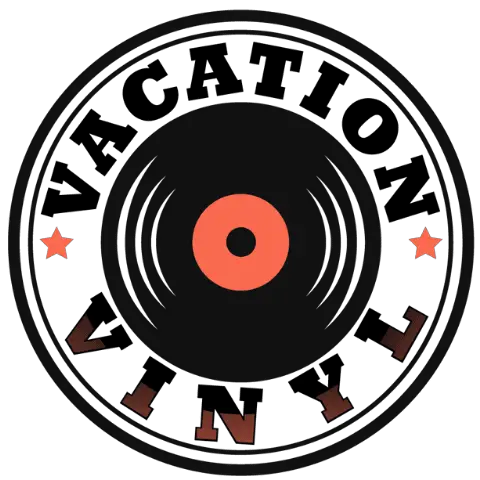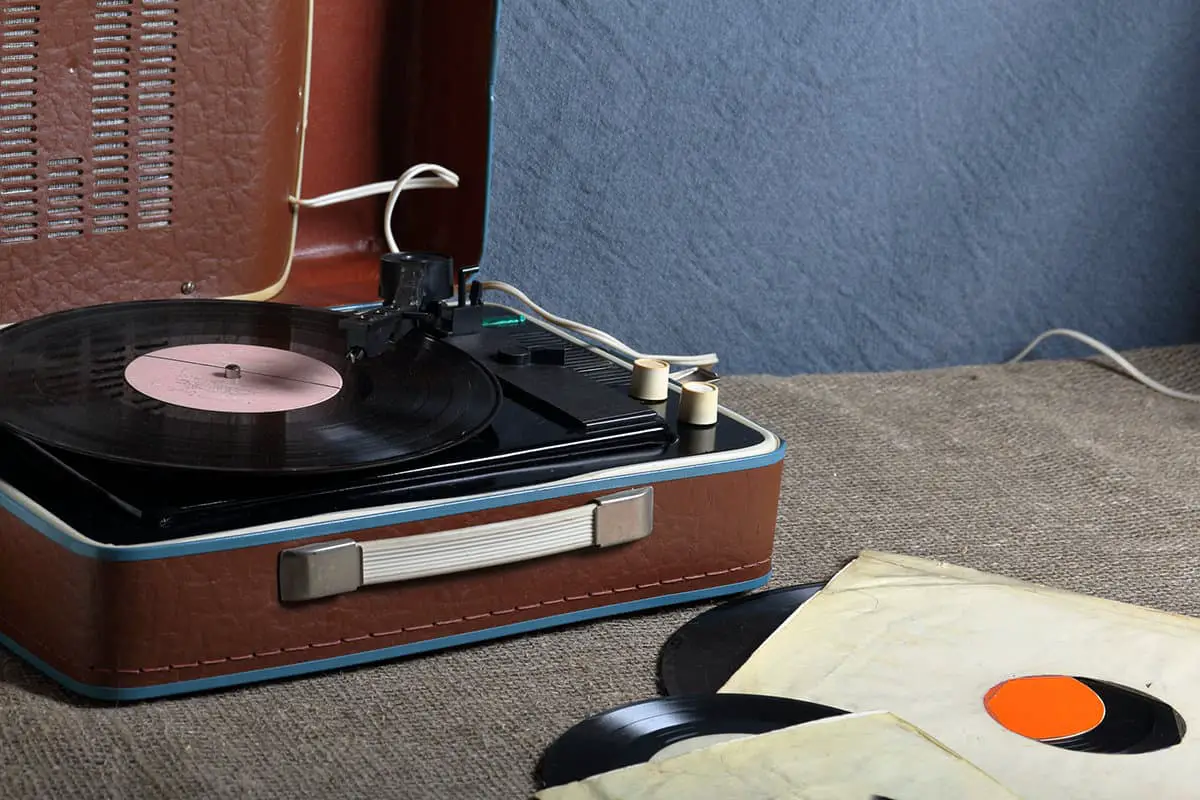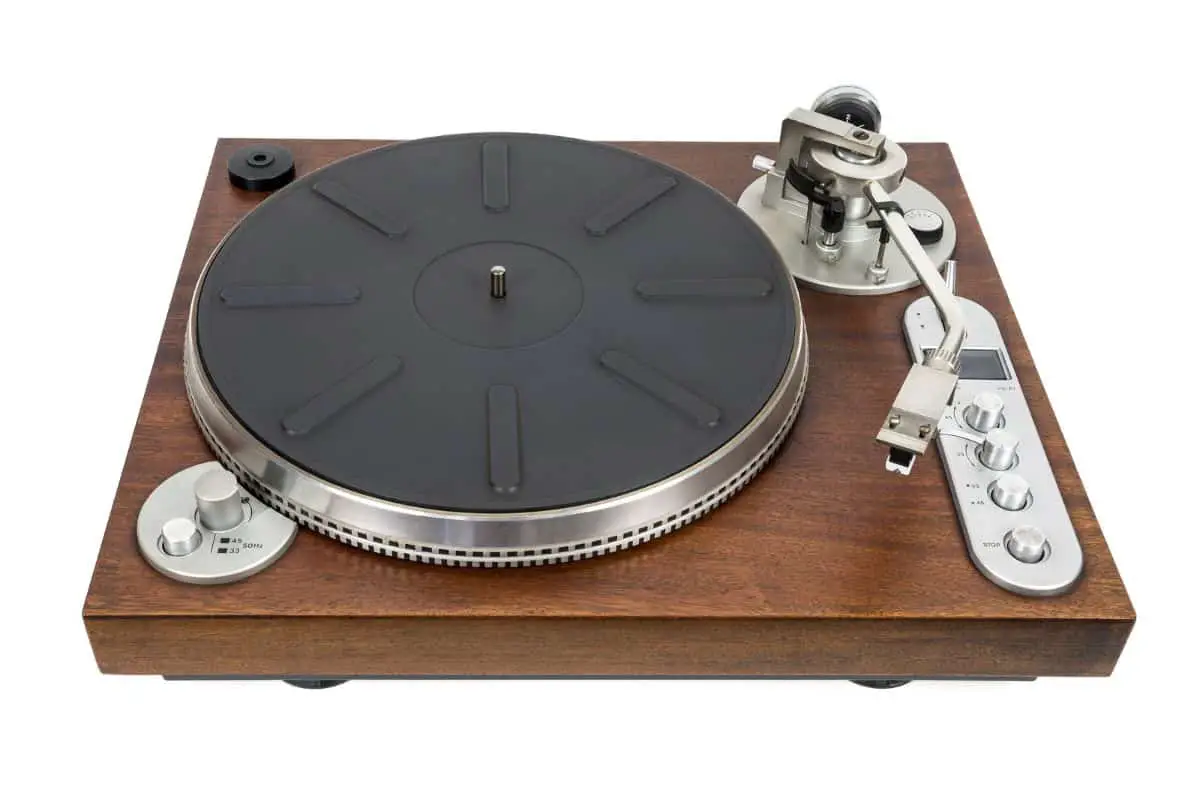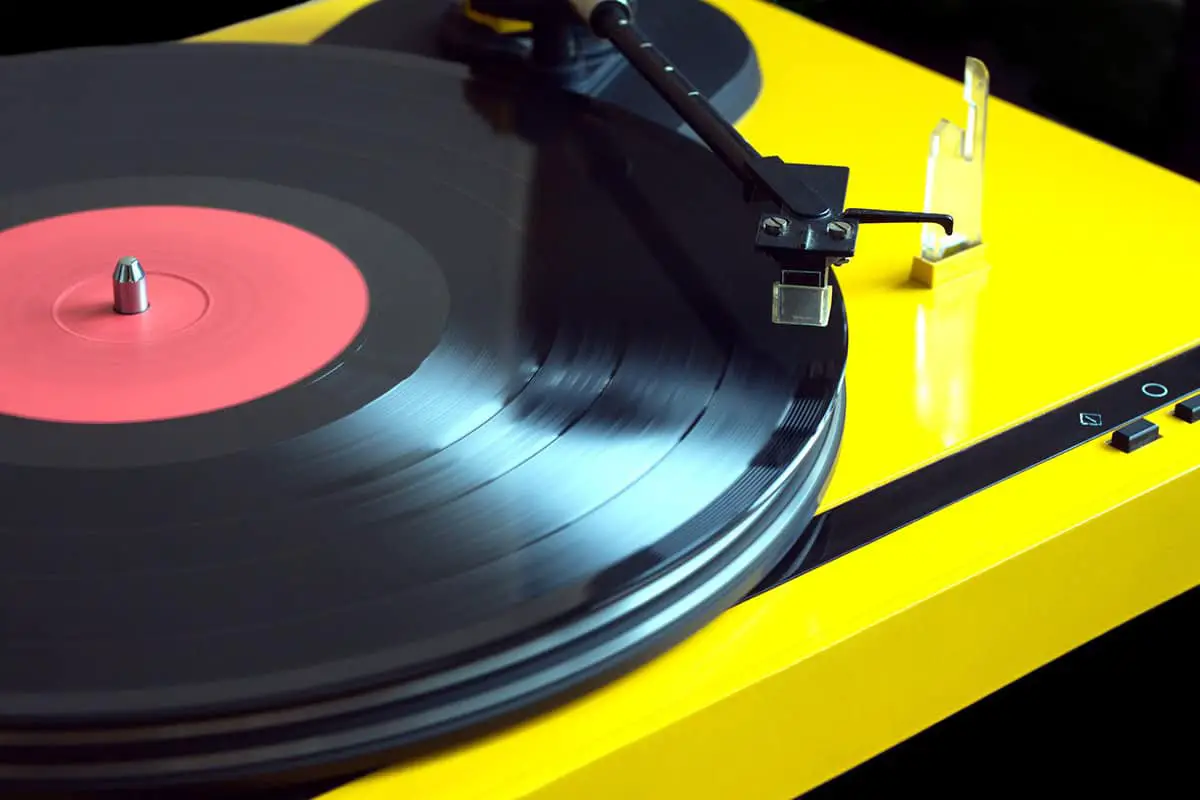This post contains affiliate links.
The record player history is a long topic to tackle. Still, many people are interested in it since it is among the most significant inventions in home entertainment history. That said, how did record players evolve through the years?
The history of record players began in 1877 when Thomas Edison invented the phonograph. Alexander Graham Bell upgraded the phonograph into the graphophone so it could record sound waves. The record player was brought out to the market in 1895. Record players seem to be coming back to the mainstream these days. So, apart from knowing the history, it is equally essential to understand why the vinyl resurgence.
Table of Contents
When Was The Record Player Invented?
The Record Player was invented in 1877, but as we mentioned before it was actually a Phonograph, but it’s considered to be the first record player. The record player was brought out to the market in 1895
The Record Player History
There is no denying that the invention of the record player is a significant step in home entertainment. From a simple turntable, this invention evolved into numerous restatements. The creation of the record player is also the reason why we enjoy digital music today.
Moreover, the record player history can be divided into six periods:
- the invention and rise of the first record player
- Emile Berliner took record players to a new level
- bringing the record player into the commercial market
- the golden age
- record players for the hip-hop scene
- the fall of record players
Looking at each period will help you understand how the invention of the record player led to how people consume music today.
The Beginning And Rise Of The First Record Player
The very first version of the turntable came out in 1857. That is when Edouard-Leon Scott de Martinville created the phonautograph device in France. However, his invention was not capable of audio playback. Instead, it could only transcribe airborne noise into paper for visual study purposes.
That said, the phonautograph’s purpose was mainly used for lab settings.
In 1887, Thomas Edison invented the phonograph. This device popularized him as the man behind the record player invention. That said, it is safe to say that Thomas Edison is responsible for why people can enjoy music today.
The phonograph worked by recording and playing sound by inscribing audio to a cardboard cylinder wrapped in tinfoil. As a result, Edison’s invention played continuous playbacks.
In the same year, Alexander Graham Bell upgraded the phonograph by adding wax to its design.
Graham Bell called his invention the graphophone. Such is a device that can record sound waves, which is a significant improvement to record players back then.
Taking Record Players To A New Level
Emile Berliner took record players to a whole new level when he created the gramophone. It consisted mainly of shellac and hard rubber before manufacturers used vinyl.
Berliner’s invention was also called the turntable. Unlike the graphophone that used a cylinder, the gramophone interpreted grooves on a flat disc. The device has a cone-shaped needle that reads the grooves of the record as it spins.
In addition, the needle, which is usually made from diamond or sapphire, hangs at the end of the tonearm. The tonearm moves across the vinyl, allowing the needle to follow the grooves on the record. This way, the needle was able to pick up vibrations and transmit them to the coil.
The coil would then turn the vibrations into electrical signals, which would travel to the amp. Finally, the speakers would turn the signals into sound, thus producing music.
Moreover, Berliner secured a patent for the gramophone in 1887.
The Mass Production Of Record Player
The record player history achieved another milestone in 1895. During this year, manufacturers released the first record player to the commercial market.
However, the gramophone record player was only popular until the emergence of the radio. The popularity of radio did not make the record player obsolete. But it indeed took away the spotlight for some time.
The advent of radio in the early 1920s made the record player industry face new challenges. It posed significant competition to record players. The reason is that the radio made the airway broadcast of music possible.
More than that, the radio’s audio quality was a lot better than the sound of record players. Such is due to a difference in the electrical sound pickup.
Moreover, the sales of record players did well in the 1930s and 1940s. But it only hit the mainstream tipping point after approximately a decade.
The Golden Age Of Record Players
Record players experienced extreme popularity in the 1960s and 1970s. This period is another milestone for the record player history. The reason is that Dual released the first turntables that have stereo playback.
It was also during this period when high-fidelity sound reproduction went out commercially. The sound quality of devices this time motivated many people to purchase a record player.
Additionally, the automatic Hi-Fi turntable also became a massive hit in the early 1960s. This era had also seen when Electrohome released the famous Apollo Record Player. (source)
Using The Record Player In The Hip-Hop Scene
The modernization in the record player history began in the 1980s and beyond. It was when hip-hop DJs creatively used turntables. They connected the record players to audio mixers and used their hands to guide the records.
That way, they could scratch the vinyl record against the needle. Doing such allows them to produce a rhythmic instrument.
Moreover, many people still use record players for their original purpose. Similarly, many hip-hop artists used turntables and mixers to add rhythm to the music. (source)
The Fall Of Record Players

By the 1980s, many families had a record player in their homes. The record player history was ongoing for a century. For this reason, these devices had gone from primitive.
However, time keeps going on, and technology progresses continuously. As a result, digital technology and compact disks made their way to the music industry.
This advancement brought a huge benefit. But it also resulted in a sharp decline in record player sales.
Still, many music enthusiasts did not let go of record players. For instance, DJ turntablism kept the format alive until the 1990s and early 2000s. (source)
More Of The Record Player History: The Vinyl Resurgence
The invention of the first record player and its improvements made modern music consumption possible. Record players turned to CDs and digital music due to various advancements.
But after years of digital music consumption, vinyl records are coming back to life. In fact, many major artists now release their albums in LP forms. For this reason, the young generation can experience the 100-year-old record player history.
Moreover, the increasing interest in vinyl records resulted in the need for modern record players. Many casual listeners and music enthusiasts alike want to experience music using vinyl. However, they also want some of music devices’ modern features, such as connecting to their smartphones and USB recording.
But regardless of the changing needs of music consumers, it is clear that record players are here to stay.
Today’s Vinyl
Looking at the record player history, you will see that vinyl only became a thing years after record players became popular.
Vinyl records made the rubber discs created by Berliner obsolete. Such records were easier to produce in high numbers. Additionally, manufacturers could easily recreate the vinyl master copies using lacquer on the cutting machine.
The master copy of a record will use the cutting head to transmit the electrical signals to the cutting machine. The said cutting head has a needle on its end. That needle cuts the grooves into the lacquer wrapped around the center of a disc.
After the cutting process, manufacturers will send the lacquer to a company that will cover it with metal, thus making the final master copy. That said, you can say that the master copy is somewhat a form of negative for a record. The reason is that manufacturers can use it every time they mass produce a record.
Moreover, companies use the metal copy of a record to create a stamper. They put it onto a hydraulic press placed with vinyl in the middle of the plates. They also use steam to soften the vinyl before stamping it.
Finally, the pressed vinyl is cooled using water, which is the final step in creating a copy of a record. (source)
The Modern Record Players
As mentioned, along with the vinyl resurgence is the need for modern record players. A lot of audiophiles and casual listeners want to experience the vintage way of listening to music. Such is proof that the record player’s history is alive and thriving in the modern-day.
However, they also want a touch of modernity and better functionality in their record players.
For this reason, companies integrated the following features to modern record players:
- USB recording
- Bluetooth connectivity
- aux and RCA connections
- speed options
Moreover, the reproduction of vintage record players has also become a big thing. These models look exactly like the vintage ones on the outside. But their interior consists of various modern features.
For instance, some of the modern record players feature built-in speakers. This way, music listeners can plug in the unit and start listening to music without the need for additional speakers and an external preamp.
Even better, many of the modern turntables sound better than the vintage ones produced in the early days of record player history. (source)
A Comparison Of Vintage And Modern Record Players

Record players have been alive for a very long time. But the invention of the cassette, the radio, and other music forms emerged. Such resulted in record players going out of fashion. Later on, vintage record players became an item for audiophiles to collect.
Still, it seems that the record player history is still not over. As mentioned, vinyl records and records players came back to life. However, there are differences between vintage and modern turntables that we need to tackle.
1. Appearance
The record player history allowed vintage turntables to have a modern counterpart. Vintage and modern record players do not have many differences in their appearance. However, vintage turntables were usually massive and had a preamp connected to them.
On the other hand, companies equipped modern record players with portability. For this reason, owners can easily place them from one place to another anytime they want.
2. Audio Quality
If you will spend money on record players, it is essential to know which sounds better between the vintage and modern ones.
There is a long record player history. For this reason, vintage turntables experienced various improvements as time passed by. So, the superior construction of vintage record players will generally produce better sound than the modern ones.
However, the sound quality of vintage turntables depends on the state of the device you have. If there is damage to a feature like a subpar stylus, the sound quality will become a mess.
On the other hand, new record players feature a mix of:
- particle boards
- alloys
- carbons and other metals.
For this reason, there is no shortage in the construction quality of these modern turntables. Thanks to the turntable’s great cartridge and stylus combination, there is also no shortage of sound quality.
What sets vintage and new turntables apart is the motor sound. Even the lower-end modern turntables do not have audible sound coming from the deck spin. For this reason, they produce warm and crystal clear sounds.
That said, modern record players sound better than vintage ones. Though the vintage ones have a long record player history, the modern turntables have more technological advancements that make them sound better.
3. Technology
A lot of technologies were not available when vintage turntables became popular. Still, some vintage record players have more advanced features than others. However, they are still primitive compared to the features possessed by modern turntables.
But depending on your needs, the features of modern record players may be irrelevant. The reason is that some of these features are not necessary for people who want to listen to music.
That said, modern record players have more features. But if you do not need these features, it is ideal to go for modern turntables.
4. Repairs
One significant thing to consider when buying a record player is if you can repair it or not. They are likely to break at least once in their lifetime, which requires you to have them repaired.
Vintage turntables are extremely durable. They do not break easily, and you will have a hard time having them repaired once they do.
The reason is that vintage record player parts are hardly available. While vintage turntables survived the long record player history, only a few companies manufacture their spare parts.
Meanwhile, new record players are also sturdy. Once they have damage, it is easy to find their spare parts and have them repaired.
So, if you want an easy repair when it comes to your turntable, you should go for modern record players. Both of them are highly durable. But new record players are a better option since there are manufacturers that produce their spare parts.
5. Prices
One significant difference that vintage and modern record players have is their prices. A good quality vintage record player will have you spend about $300 if you buy one these days. Such is already an excellent deal considering the century-long record player history.
On the other hand, a modern turntable costs approximately $300 for its most basic settings. Yet, you will not have much playtime with the audio on a device this cheap.
Moreover, you need to spend about $1000 if you want a high-quality modern record player.
So, the best option in terms of the price for turntables is the vintage ones. Still, buying a vintage record player means that you need to get extra speakers and an amplifier, thus increasing the cost. But if you will go for a modern record player, you will have to spend double the amount of money.
6. Ease of use
Another essential feature for professionals and amateurs alike is system usage. That said, vintage turntables are extremely easy to use. They possess straightforward settings and uncomplicated usage processes.
Vintage turntables are also fully automated despite the record player history going on for more than a century. For this reason, there isn’t much for users to do except configuring the device’s basic settings and enjoy music.
The new record players have all their features in manual mode. So, these modern versions of turntables are not even partially automated. That means you need to lift the platter a lot of times when you are using the device.
In addition, you need to set all the features with maximum knowledge. For this reason, modern record players may not suit amateur users.
Furthermore, it should seem those modern record players are the most convenient to use. But the truth is they are not. Vintage record players are easier to use despite the century-old record player history.
In addition, vintage music devices are much more automated than modern ones. (source)
Related Articles
Sources
- Dr. Richard Osborne, Vinyl: A History of the Analogue Record, accessed November 4, 2021.
- Bill Brewster, Frank Broughton, The Record Players: DJ Revolutionaries, accessed November 4, 2021.
- William Howland Kenney, Recorded Music in American Life: The Phonograph and Popular Memory, accessed November 5, 2021.
- Paul E. Winters, Vinyl Records, and Analog Culture in the Digital Age: Pressing Matters, accessed November 5, 2021.
- Owen Gough, The 8 Best Record Players to Make You Love Vinyl Again in 2021, https://www.esquire.com/uk/design/g33942911/record-players/, accessed November 5, 2021.
- Vintage Record Player vs New, https://victrola.com/blogs/articles/vintage-record-player-vs-new, accessed November 5, 2021.
VacationVinyl.com is a participant in the Amazon Services LLC Associates Program, an affiliate advertising program designed to provide a means for sites to earn advertising fees by advertising and linking to Amazon.com. We also participate in other affiliate programs which compensate us for referring traffic.




